Page 392 of 481
391 Practical hints
What to do if …?
Display symbolDisplay messagePossible cause/consequencePossible solution
1Restraint system
malfunction
Visit workshopThe system is malfunctioning.�Drive with added caution to the near-
est authorized Mercedes-Benz Center.
Warning!G
In the event a malfunction of the SRS is indi-
cated as outlined above, the SRS may not be
operational.
For your safety, we strongly recommend
that you visit an authorized Mercedes-Benz
Center immediately to have the system
checked; otherwise the SRS may not be de-
ploy when needed in an accident, which
could result in serious or fatal injury, or it
might deploy unexpectedly and unnecessar-
ily which could also result in injury.
Page 393 of 481
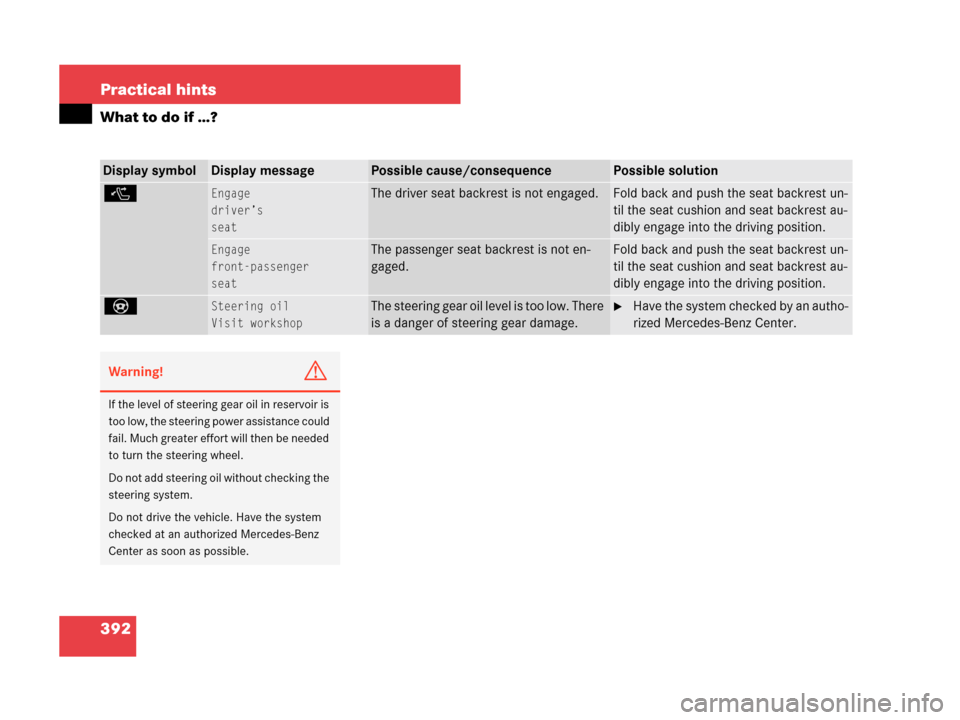
392 Practical hints
What to do if …?
Display symbolDisplay messagePossible cause/consequencePossible solution
(Engage
driver’s
seatThe driver seat backrest is not engaged.Fold back and push the seat backrest un-
til the seat cushion and seat backrest au-
dibly engage into the driving position.
Engage
front-passenger
seatThe passenger seat backrest is not en-
gaged.Fold back and push the seat backrest un-
til the seat cushion and seat backrest au-
dibly engage into the driving position.
_ Steering oil
Visit workshopThe steering gear oil level is too low. There
is a danger of steering gear damage.�Have the system checked by an autho-
rized Mercedes-Benz Center.
Warning!G
If the level of steering gear oil in reservoir is
too low, the steering power assistance could
fail. Much greater effort will then be needed
to turn the steering wheel.
Do not add steering oil without checking the
steering system.
Do not drive the vehicle. Have the system
checked at an authorized Mercedes-Benz
Center as soon as possible.
Page 396 of 481
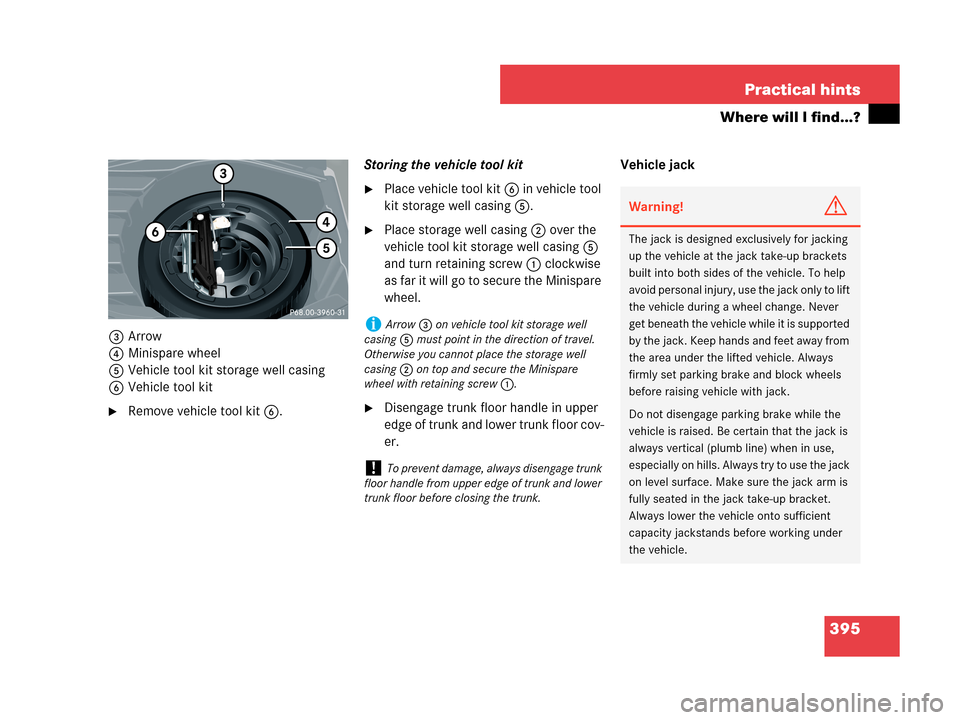
395 Practical hints
Where will I find...?
3Arrow
4Minispare wheel
5Vehicle tool kit storage well casing
6Vehicle tool kit
�Remove vehicle tool kit6.Storing the vehicle tool kit
�Place vehicle tool kit6 in vehicle tool
kit storage well casing5.
�Place storage well casing2 over the
vehicle tool kit storage well casing5
and turn retaining screw1 clockwise
as far it will go to secure the Minispare
wheel.
�Disengage trunk floor handle in upper
edge of trunk and lower trunk floor cov-
er.Vehicle jack
iArrow3 on vehicle tool kit storage well
casing5 must point in the direction of travel.
Otherwise you cannot place the storage well
casing2 on top and secure the Minispare
wheel with retaining screw1.
!To prevent damage, always disengage trunk
floor handle from upper edge of trunk and lower
trunk floor before closing the trunk.
Warning!G
The jack is designed exclusively for jacking
up the vehicle at the jack take-up brackets
built into both sides of the vehicle. To help
avoid personal injury, use the jack only to lift
the vehicle during a wheel change. Never
get beneath the vehicle while it is supported
by the jack. Keep hands and feet away from
the area under the lifted vehicle. Always
firmly set parking brake and block wheels
before raising vehicle with jack.
Do not disengage parking brake while the
vehicle is raised. Be certain that the jack is
always vertical (plumb line) when in use,
especially on hills. Always try to use the jack
on level surface. Make sure the jack arm is
fully seated in the jack take-up bracket.
Always lower the vehicle onto sufficient
capacity jackstands before working under
the vehicle.
Page 399 of 481
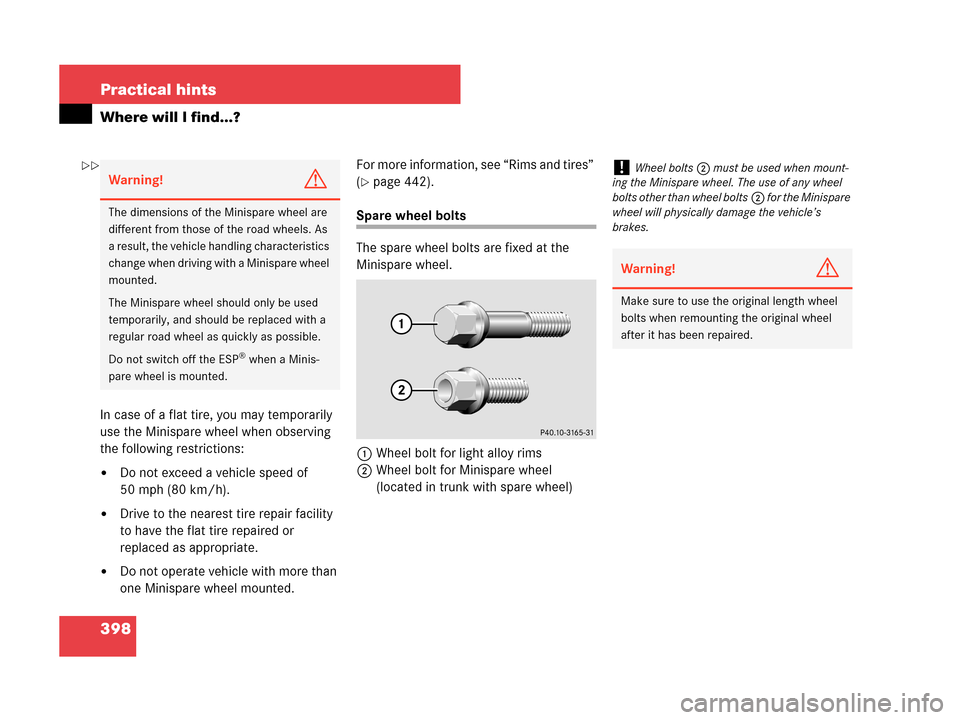
398 Practical hints
Where will I find...?
In case of a flat tire, you may temporarily
use the Minispare wheel when observing
the following restrictions:
�Do not exceed a vehicle speed of
50 mph (80 km/h).
�Drive to the nearest tire repair facility
to have the flat tire repaired or
replaced as appropriate.
�Do not operate vehicle with more than
one Minispare wheel mounted.For more information, see “Rims and tires”
(
�page 442).
Spare wheel bolts
The spare wheel bolts are fixed at the
Minispare wheel.
1Wheel bolt for light alloy rims
2Wheel bolt for Minispare wheel
(located in trunk with spare wheel)
Warning!G
The dimensions of the Minispare wheel are
different from those of the road wheels. As
a result, the vehicle handling characteristics
change when driving with a Minispare wheel
mounted.
The Minispare wheel should only be used
temporarily, and should be replaced with a
regular road wheel as quickly as possible.
Do not switch off the ESP
® when a Minis-
pare wheel is mounted.
!Wheel bolts2 must be used when mount-
ing the Minispare wheel. The use of any wheel
bolts other than wheel bolts2 for the Minispare
wheel will physically damage the vehicle’s
brakes.
Warning!G
Make sure to use the original length wheel
bolts when remounting the original wheel
after it has been repaired.
��
Page 404 of 481
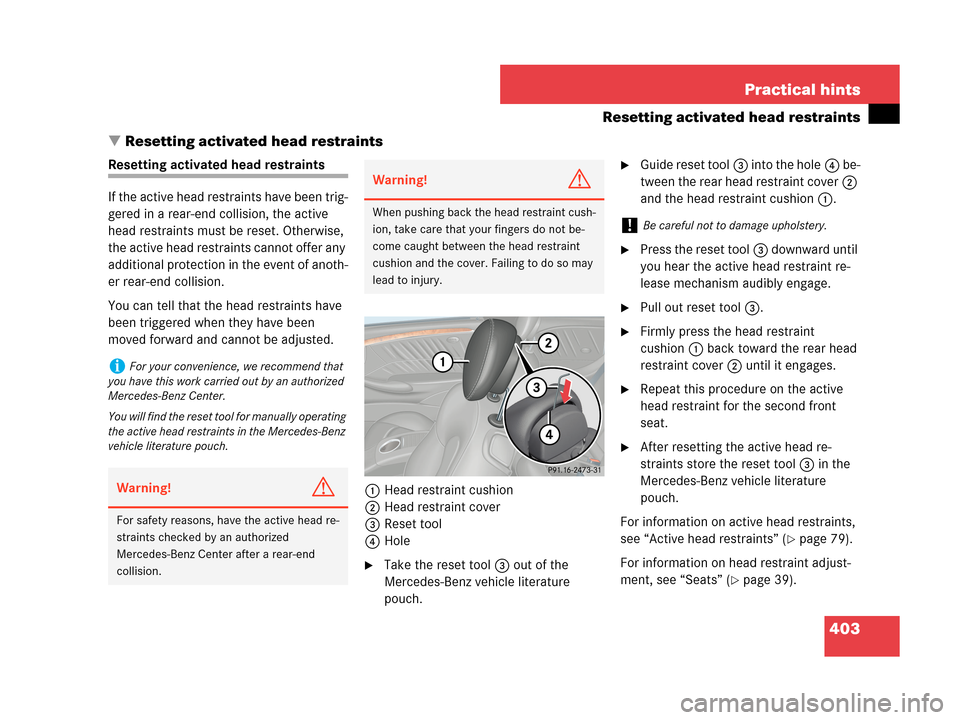
403 Practical hints
Resetting activated head restraints
�Resetting activated head restraints
Resetting activated head restraints
If the active head restraints have been trig-
gered in a rear-end collision, the active
head restraints must be reset. Otherwise,
the active head restraints cannot offer any
additional protection in the event of anoth-
er rear-end collision.
You can tell that the head restraints have
been triggered when they have been
moved forward and cannot be adjusted.
1Head restraint cushion
2Head restraint cover
3Reset tool
4Hole
�Take the reset tool3 out of the
Mercedes-Benz vehicle literature
pouch.
�Guide reset tool3 into the hole4 be-
tween the rear head restraint cover2
and the head restraint cushion1.
�Press the reset tool3 downward until
you hear the active head restraint re-
lease mechanism audibly engage.
�Pull out reset tool3.
�Firmly press the head restraint
cushion1 back toward the rear head
restraint cover2 until it engages.
�Repeat this procedure on the active
head restraint for the second front
seat.
�After resetting the active head re-
straints store the reset tool3 in the
Mercedes-Benz vehicle literature
pouch.
For information on active head restraints,
see “Active head restraints” (
�page 79).
For information on head restraint adjust-
ment, see “Seats” (
�page 39).
iFor your convenience, we recommend that
you have this work carried out by an authorized
Mercedes-Benz Center.
You will find the reset tool for manually operating
the active head restraints in the Mercedes-Benz
vehicle literature pouch.
Warning!G
For safety reasons, have the active head re-
straints checked by an authorized
Mercedes-Benz Center after a rear-end
collision.
Warning!G
When pushing back the head restraint cush-
ion, take care that your fingers do not be-
come caught between the head restraint
cushion and the cover. Failing to do so may
lead to injury.!Be careful not to damage upholstery.
Page 405 of 481
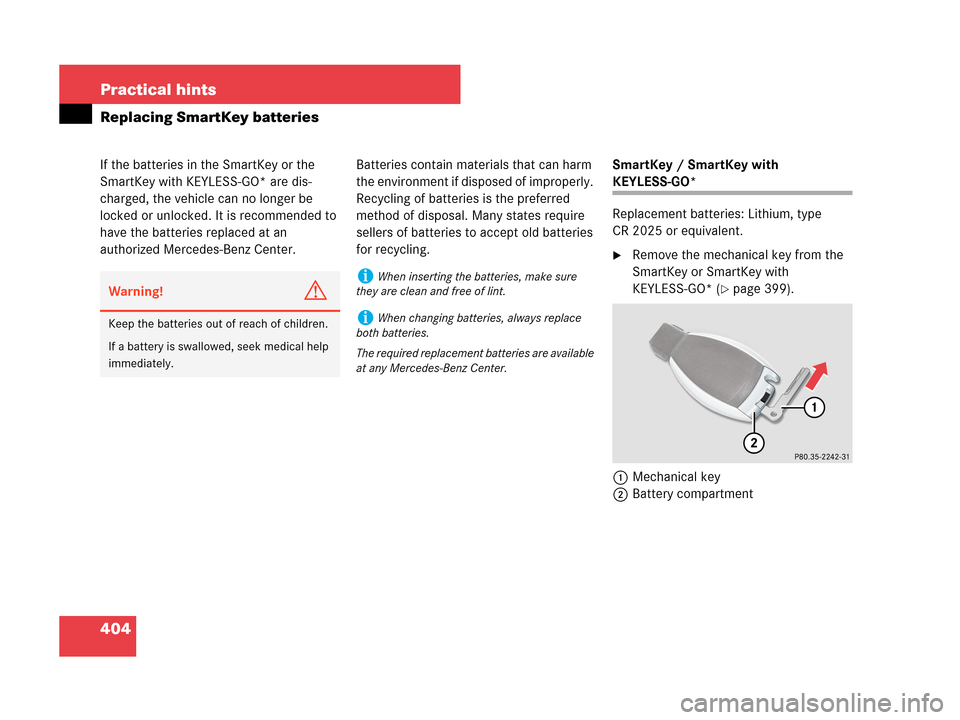
404 Practical hints
Replacing SmartKey batteries
If the batteries in the SmartKey or the
SmartKey with KEYLESS-GO* are dis-
charged, the vehicle can no longer be
locked or unlocked. It is recommended to
have the batteries replaced at an
authorized Mercedes-Benz Center.Batteries contain materials that can harm
the environment if disposed of improperly.
Recycling of batteries is the preferred
method of disposal. Many states require
sellers of batteries to accept old batteries
for recycling.SmartKey / SmartKey with
KEYLESS-GO*
Replacement batteries: Lithium, type
CR 2025 or equivalent.
�Remove the mechanical key from the
SmartKey or SmartKey with
KEYLESS-GO* (
�page 399).
1Mechanical key
2Battery compartmentWarning!G
Keep the batteries out of reach of children.
If a battery is swallowed, seek medical help
immediately.
iWhen inserting the batteries, make sure
they are clean and free of lint.
iWhen changing batteries, always replace
both batteries.
The required replacement batteries are available
at any Mercedes-Benz Center.
Page 409 of 481
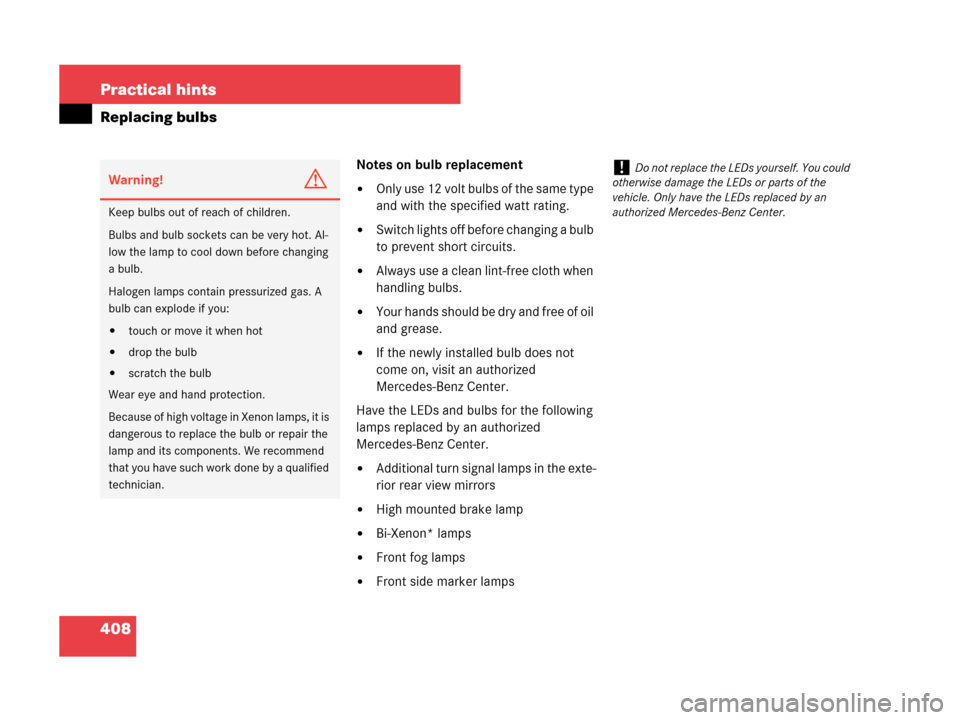
408 Practical hints
Replacing bulbs
Notes on bulb replacement
�Only use 12 volt bulbs of the same type
and with the specified watt rating.
�Switch lights off before changing a bulb
to prevent short circuits.
�Always use a clean lint-free cloth when
handling bulbs.
�Your hands should be dry and free of oil
and grease.
�If the newly installed bulb does not
come on, visit an authorized
Mercedes-Benz Center.
Have the LEDs and bulbs for the following
lamps replaced by an authorized
Mercedes-Benz Center.
�Additional turn signal lamps in the exte-
rior rear view mirrors
�High mounted brake lamp
�Bi-Xenon* lamps
�Front fog lamps
�Front side marker lamps
Warning!G
Keep bulbs out of reach of children.
Bulbs and bulb sockets can be very hot. Al-
low the lamp to cool down before changing
a bulb.
Halogen lamps contain pressurized gas. A
bulb can explode if you:
�touch or move it when hot
�drop the bulb
�scratch the bulb
Wear eye and hand protection.
Because of high voltage in Xenon lamps, it is
dangerous to replace the bulb or repair the
lamp and its components. We recommend
that you have such work done by a qualified
technician.
!Do not replace the LEDs yourself. You could
otherwise damage the LEDs or parts of the
vehicle. Only have the LEDs replaced by an
authorized Mercedes-Benz Center.
Page 411 of 481
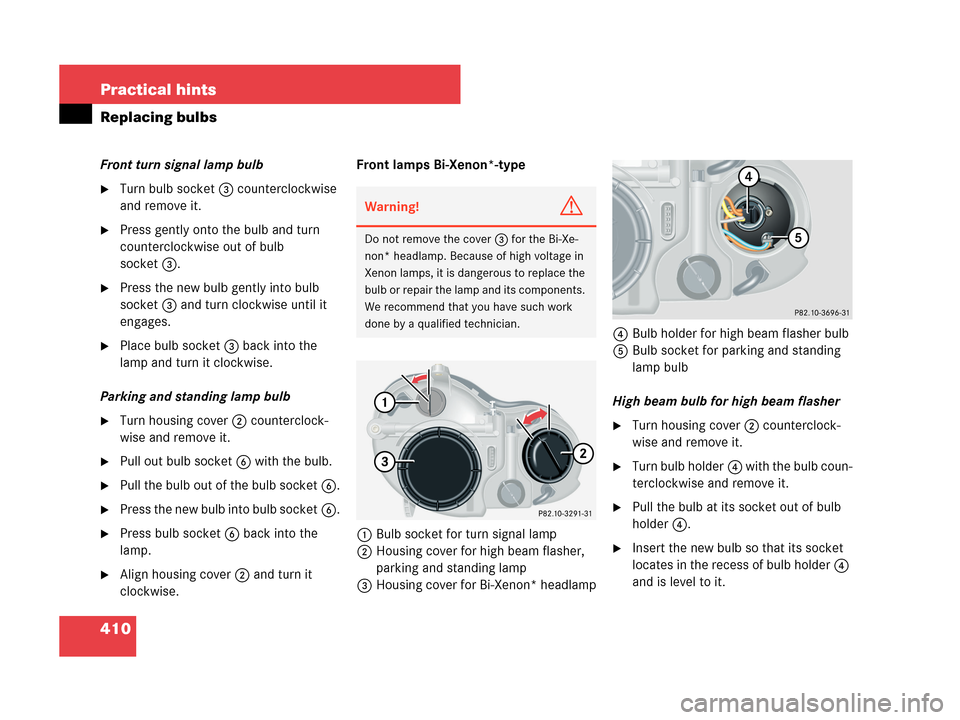
410 Practical hints
Replacing bulbs
Front turn signal lamp bulb
�Turn bulb socket3 counterclockwise
and remove it.
�Press gently onto the bulb and turn
counterclockwise out of bulb
socket3.
�Press the new bulb gently into bulb
socket3 and turn clockwise until it
engages.
�Place bulb socket3 back into the
lamp and turn it clockwise.
Parking and standing lamp bulb
�Turn housing cover2 counterclock-
wise and remove it.
�Pull out bulb socket6 with the bulb.
�Pull the bulb out of the bulb socket6.
�Press the new bulb into bulb socket6.
�Press bulb socket6 back into the
lamp.
�Align housing cover2 and turn it
clockwise.Front lamps Bi-Xenon*-type
1Bulb socket for turn signal lamp
2Housing cover for high beam flasher,
parking and standing lamp
3Housing cover for Bi-Xenon* headlamp4Bulb holder for high beam flasher bulb
5Bulb socket for parking and standing
lamp bulb
High beam bulb for high beam flasher
�Turn housing cover2 counterclock-
wise and remove it.
�Turn bulb holder4 with the bulb coun-
terclockwise and remove it.
�Pull the bulb at its socket out of bulb
holder4.
�Insert the new bulb so that its socket
locates in the recess of bulb holder4
and is level to it.
Warning!G
Do not remove the cover 3 for the Bi-Xe-
non* headlamp. Because of high voltage in
Xenon lamps, it is dangerous to replace the
bulb or repair the lamp and its components.
We recommend that you have such work
done by a qualified technician.